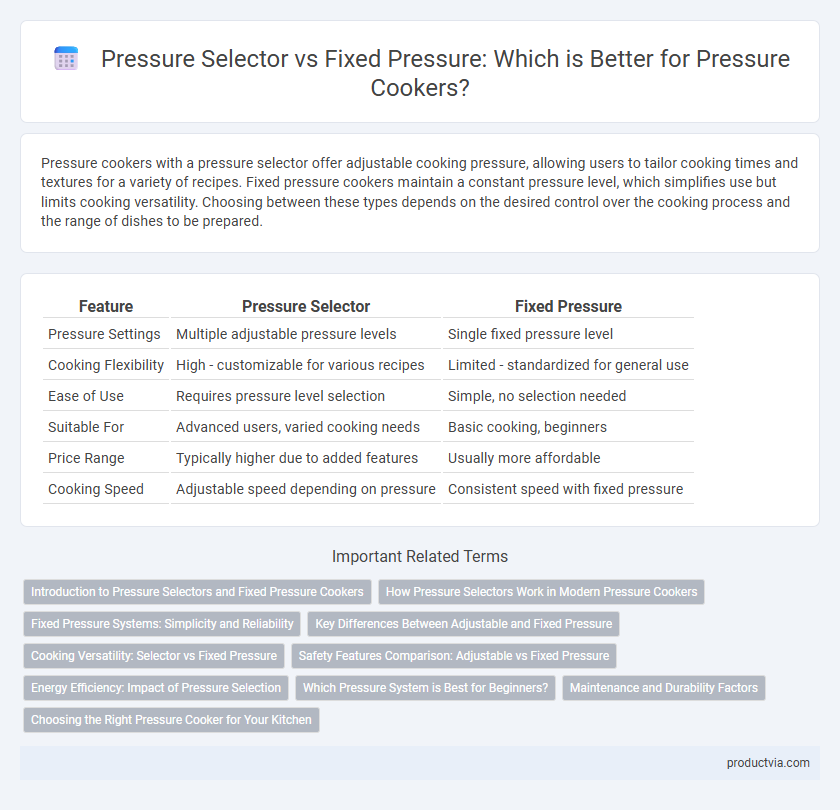Pressure cookers with a pressure selector offer adjustable cooking pressure, allowing users to tailor cooking times and textures for a variety of recipes. Fixed pressure cookers maintain a constant pressure level, which simplifies use but limits cooking versatility. Choosing between these types depends on the desired control over the cooking process and the range of dishes to be prepared.
Table of Comparison
| Feature | Pressure Selector | Fixed Pressure |
|---|---|---|
| Pressure Settings | Multiple adjustable pressure levels | Single fixed pressure level |
| Cooking Flexibility | High - customizable for various recipes | Limited - standardized for general use |
| Ease of Use | Requires pressure level selection | Simple, no selection needed |
| Suitable For | Advanced users, varied cooking needs | Basic cooking, beginners |
| Price Range | Typically higher due to added features | Usually more affordable |
| Cooking Speed | Adjustable speed depending on pressure | Consistent speed with fixed pressure |
Introduction to Pressure Selectors and Fixed Pressure Cookers
Pressure selectors in pressure cookers allow precise control over cooking pressure, enabling users to switch between multiple pressure levels for versatile cooking applications. Fixed pressure cookers maintain a constant pressure setting, typically optimized for general recipes, which simplifies operation but limits customization. Understanding the distinction helps users select the appropriate cooker based on their cooking style and recipe requirements.
How Pressure Selectors Work in Modern Pressure Cookers
Pressure selectors in modern pressure cookers regulate internal steam pressure by adjusting the venting mechanism, allowing users to choose different cooking pressures for varied recipes. These selectors enable precise control over temperature, improving cooking efficiency and texture outcomes, unlike fixed pressure models that operate at a single, constant pressure setting. By modulating pressure levels, pressure selectors enhance versatility and safety, reducing the risk of overcooking or burning food.
Fixed Pressure Systems: Simplicity and Reliability
Fixed pressure systems in pressure cookers offer unmatched simplicity and reliability by operating at a constant pressure level, typically 15 psi, ensuring consistent cooking results without user adjustments. These systems reduce mechanical complexity and potential failure points, making them ideal for everyday cooking tasks where ease of use is prioritized. Fixed pressure cookers are favored in traditional models for their durability and straightforward operation, providing stable steam pressure for efficient and safe food preparation.
Key Differences Between Adjustable and Fixed Pressure
Pressure cookers with an adjustable pressure selector allow users to choose between multiple pressure levels, offering versatility for cooking different types of food with precision, whereas fixed pressure models operate at a single, pre-set pressure level optimized for general use. Adjustable pressure cookers enhance cooking control and efficiency by enabling fine-tuning of pressure, which can impact cooking time and texture, while fixed pressure cookers provide simplicity and reliability with fewer user adjustments needed. The key difference lies in user flexibility versus straightforward operation, with adjustable selectors catering to diverse culinary demands and fixed models focusing on consistent performance.
Cooking Versatility: Selector vs Fixed Pressure
Pressure cookers with a pressure selector offer enhanced cooking versatility by allowing users to adjust the pressure settings for different recipes, accommodating delicate foods or tougher ingredients with precise control. Fixed pressure cookers generally operate at a single, consistent pressure level, simplifying use but limiting adaptability for various cooking needs. Choosing a pressure cooker with a selector provides greater flexibility in achieving optimal texture and flavor across a wider range of dishes.
Safety Features Comparison: Adjustable vs Fixed Pressure
Adjustable pressure selectors in pressure cookers offer enhanced safety by allowing users to control cooking pressure levels, reducing the risk of over-pressurization and ensuring optimal heat management. Fixed pressure cookers maintain a constant, predetermined pressure, which simplifies operation but may limit flexibility in cooking different foods and can pose higher risks if pressure release mechanisms fail. Overall, adjustable pressure models provide superior safety features through customizable pressure settings and more precise control over steam release, minimizing hazards associated with pressure buildup.
Energy Efficiency: Impact of Pressure Selection
Pressure cookers with pressure selectors allow users to adjust cooking pressure, optimizing energy consumption by matching pressure levels to specific recipes, thus reducing cooking time and energy use. Fixed pressure cookers operate at a constant pressure, potentially leading to unnecessary energy expenditure for dishes that require lower pressure settings. Selecting the appropriate pressure enhances thermal efficiency, decreases fuel consumption, and minimizes overall energy costs during cooking.
Which Pressure System is Best for Beginners?
Pressure cookers with a fixed pressure system offer a straightforward, user-friendly experience ideal for beginners, as they eliminate the guesswork involved in adjusting settings. Pressure selector models provide more versatility by allowing users to choose different pressure levels, but beginners might find this complexity challenging. For those new to pressure cooking, a fixed pressure cooker ensures easier operation and consistent cooking results.
Maintenance and Durability Factors
Pressure cookers with pressure selectors offer customizable pressure settings, allowing users to adjust cooking intensity to reduce wear and tear on seals and valves, enhancing maintenance ease and extending durability. Fixed pressure cookers have simpler mechanisms with fewer moving parts, resulting in lower maintenance requirements and increased reliability but limited flexibility in pressure control. The choice impacts longevity, as pressure selectors may require more frequent servicing to maintain optimal performance, while fixed pressure models benefit from robust, low-maintenance designs.
Choosing the Right Pressure Cooker for Your Kitchen
Pressure cookers with a pressure selector offer adjustable cooking levels, allowing precise control over steam pressure for diverse recipes, while fixed pressure models provide consistent pressure settings suited for simplified, repeatable cooking tasks. Selecting the right pressure cooker depends on your culinary preferences, frequency of use, and recipe variety, as pressure selector cookers enhance versatility and fixed pressure units emphasize ease of use and reliability. Kitchen size and budget considerations also influence the decision, with pressure selector models typically priced higher due to their advanced features.
Pressure selector vs Fixed pressure for pressure cookers Infographic

 productvia.com
productvia.com